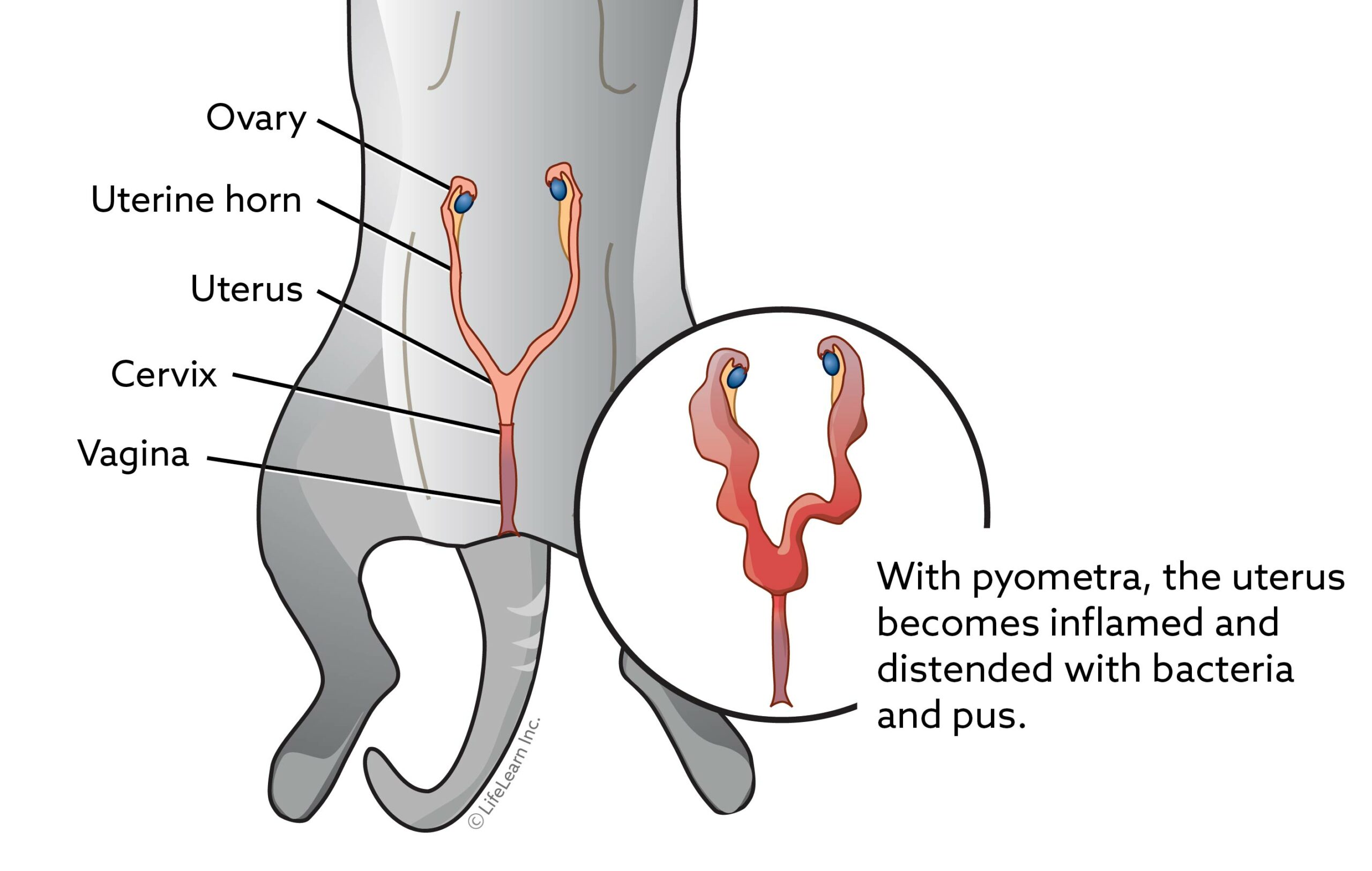Pyometra
What is pyometra?
Pyometra is a secondary infection that occurs as a result of hormonal changes in the female's reproductive tract. Following estrus (heat), the hormone progesterone remains elevated for up to two months and causes the lining of the uterus to thicken in preparation for pregnancy. If pregnancy does not occur for several consecutive estrus cycles, the uterine lining continues to increase in thickness until cysts form within the uterine tissues (a condition called cystic endometrial hyperplasia). The thickened, cystic lining secretes fluids that create an ideal environment for bacterial growth.
In addition, the muscles of the uterus cannot contract properly either due to thickening of the uterine wall or the high levels of the hormone progesterone. This means that bacteria that enters the uterus and fluids that have accumulated cannot be expelled.
During estrus, white blood cells, which would normally protect against infection by eliminating bacteria, are inhibited from entering the uterus. This normal occurrence allows sperm to safely enter the female's reproductive tract without being damaged or destroyed by these immune system cells.The combination of these three factors can often lead to life threatening infection.
How do bacteria enter the uterus?
The cervix is the gateway to the uterus. It remains tightly closed except during estrus, when it relaxes to allow sperm to enter the uterus. If the cervix is open or relaxed, bacteria that are normally found in the vagina can easily enter the uterus. If the uterus is ‘normal’, the uterine environment prevents bacterial survival; however, when the uterine wall has become thickened or cystic, due to cystic endometrial hyperplasia, perfect conditions exist for bacterial growth.
When does pyometra occur?
Pyometra may occur in any sexually intact young to middle-aged cats and dogs; however, it is most common in older age.After many years of estrus cycles without pregnancy, the uterine wall undergoes the changes that promote this disease. Pyometra usually occurs two to eight weeks after the last estrus (heat cycle).
What are the clinical signs of pyometra?
The clinical signs depend on whether or not the cervix remains open. If it is open, pus will drain from the uterus through the vagina to the outside. Pus or an abnormal discharge is often seen on the skin or hair under the tail or on bedding and furniture where the cats and dogs has recently laid. Fever, lethargy, anorexia, and depression may or may not be present.
If the cervix is closed, pus that forms is not able to drain to the outside. It collects in the uterus ultimately causing the abdomen to distend. The bacteria release toxins that are absorbed into the bloodstream. Cats and dogs with closed pyometra become severely ill very rapidly. They are anorectic, very listless and very depressed. Vomiting or diarrhea may also be present.
Toxins released by the bacteria affect the kidney's ability to retain fluid. Increased urine production occurs, and many of them drink an excess of water to compensate. Increased water consumption may occur in both open- and closed-cervix pyometra.

How is pyometra diagnosed?
Cats and dogs that are examined early in the course of the disease may have a slight vaginal discharge and show no other signs of illness. However, most of them with pyometra are seen later in the illness. A very ill cat or dog with a history of recent heat that is drinking an increased amount of water should be suspected of having pyometra. This is especially true if there is a vaginal discharge or a painful, enlarged abdomen.
Patients with pyometra usually have a severe elevation of the white blood cell count and often have an elevation of globulins (a type of protein often associated with the immune system) in the blood. The specific gravity (concentration) of the urine is generally low due to the toxic effects of the bacteria on the kidneys. However, these changes are non-specific and may be present in any dog with a major bacterial infection.
If the cervix is closed, radiographs (X-rays) of the abdomen will often identify the enlarged uterus. If the cervix is open, there will often be such minimal uterine enlargement that the radiograph will be inconclusive. An ultrasound examination may be helpful in identifying an enlarged uterus and differentiating that from a normal pregnancy. Ultrasound changes that indicate pyometra include increased uterine size, thickened uterine walls, and fluid accumulation within the uterus.
How is pyometra treated?
The preferred treatment is to surgically remove the infected uterus and ovaries by performing an ovariohysterectomy (spay). Cats and dogs diagnosed in the early stage of the disease are very good surgical candidates. The surgery is somewhat more complicated than a routine spay at this stage. However, most patients are diagnosed with pyometra when they are quite ill resulting in a more complicated surgical procedure and a longer period of hospitalization. Intravenous fluids are required to stabilize the patients before and after surgery. Antibiotics are usually given for two weeks after surgery.



